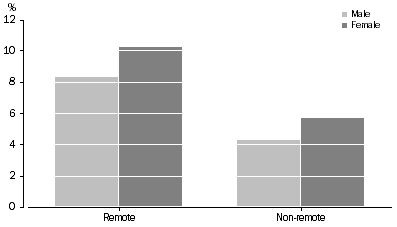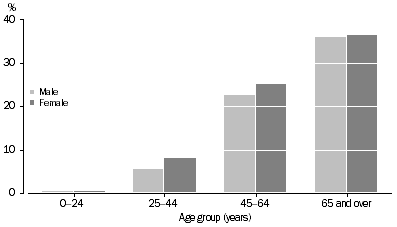|
 DIABETES IN ABORIGINAL AND TORRES STRAIT ISLANDER PEOPLE DIABETES IN ABORIGINAL AND TORRES STRAIT ISLANDER PEOPLE
About six out of every 100 Aboriginal and Torres Strait Islander people (or 6%) reported diabetes or high sugar levels (HSL) as a long-term health condition.
Indigenous people living in remote areas had higher rates of diabetes or HSL (9%) than those living in non-remote areas (5%), such as major cities and towns.
Indigenous people with diabetes (or HSL), 2004-05

Diabetes rates for males and females
Indigenous females were more likely than Indigenous males to have diabetes or HSL with seven out of every 100 Indigenous females (or 7%) affected, compared to 5% of Indigenous males.
Ten percent of Indigenous females living in remote areas had diabetes or HSL; nearly double the rate for Indigenous females living in non-remote areas (6%). The same pattern occurred for males (8% compared to 4%).
Age of Indigenous people with diabetes (or HSL), 2004-05

Diabetes and age
The prevalence of diabetes or HSL increases with age. Of Indigenous people aged 65 years and over, 36% had diabetes or HSL. In contrast, the rate for those aged 0 to 24 years old was only 1%. |
 Print Page
Print Page
 Print All
Print All